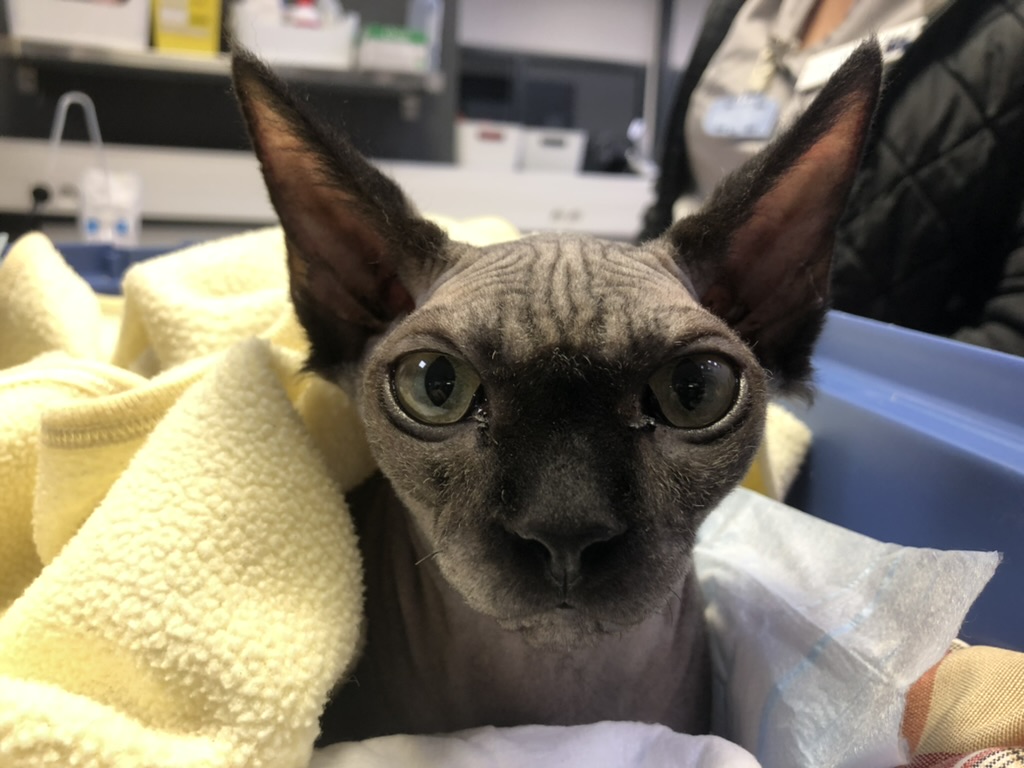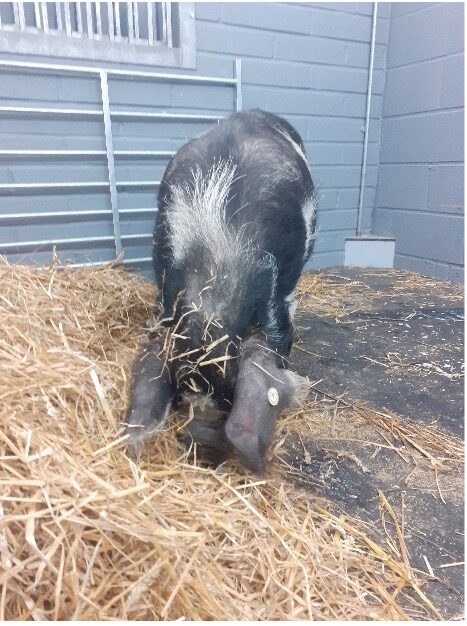Toscane, the Sphynx cat who underwent a faecal transplantation
Toscane, a 9mth old female neutered Sphynx cat
Before visiting the Specialist.
Animal Treated
Dog
Animal Condition
Elbow pain
Specialist(s) Required
Orthopaedic surgery
Diagnostic imaging
Physiotherapy
Anaesthesia and Analgeia
Maia, a Parson Terrier with skipping lameness.
Before visiting the Specialist
Maia is a cute little Parson Terrier who had a long term skipping lameness on her left hindlimb. She soon began to be more wary of the other dog in the house and would often attack him. Behavioural changes such as this can be easily linked to pain. Over time the skipping became more frequent and a course of meloxicam (pain medication) was prescribed. This resulted in an improvement in her behaviour towards other dogs.
Keen to get to the bottom of the problem, Maia’s vet took some stifle radiographs which were normal. Palpation for a patella luxation was unrewarding. With the obvious problems ruled out, Maia was then referred to an orthopaedic specialist.
Maia’s Investigation
After examining Maia, the orthopaedic specialist, who was also a little perplexed, was unable to find a specific source which could account for Maia’s problem.
It wasn’t until Maia’s meloxicam course came to an end that clues to the source of the problem started to appear. Maia started chewing her left forelimb and again, became less tolerant of the other dog in the house. This led the specialist to question whether the problem was actually in the forelimb and the hindlimb was a non-significant terrier skipping lameness – a frustrating problem but one that rarely requires treatment. Maia was not limping, but on examination, there was pain evident in her left elbow.
CT of the elbow identified evidence of ‘humeroulnar incongruity and secondary osteoarthritis’, which could account for her elbow discomfort.
Maia’s treatment and progress
Since the localisation of Maia’s problem was not straight-forward, the decision was made to give her a pain relieving and anti-inflammatory injection in her left elbow to make sure that the exact problem was identified.
This resulted in a significant improvement in Maia’s pain and behaviour. Unfortunately, the improvement of the injection was relatively short-lived. Maia, therefore, had surgery on her elbow to improve the underlying elbow deformity.
Maia’s surgery went well and her road to recovery began with our physiotherapy team right by her side. Our aim is for every surgery patient to have a tailored rehabilitation plan for their owners to work on at home. Encouraging movement in the operated area without causing pain has been shown to improve strength and fasten recovery. In the weeks after her surgery, Maia made excellent progress.
Over time Maia’s owner noticed a recurrence of some of Maia’s previous signs which she associated with pain. After a discussion with Maia’s physiotherapist, it became clear that pain was once again a problem. The next step and recommendation to Maia and her owners was a consultation with our pain management service.
The main objective is always to get a handle on the degree of pain and how that pain affects the patient on a day to day basis – we always say that pain is whatever the patient says it is. Many specialists find The Canine Brief Pain Inventory1 (CBPI) is really useful for assessing this.
Maia scored highly on both elements of the CBPI giving us clear information that further pain relief was necessary. Explaining the concept of ‘maladaptive’ pain, which means pain that serves no useful purpose, was really useful to the owner in her understanding of what we are treating and trying to achieve with Maia. This also helps to reinforce the importance of ongoing pain relief and the importance of targeted rehabilitation through exercise and physiotherapy in an overall multimodal approach.
The pain relief, which proved most effective in Maia was a combination of meloxicam and amantadine and the owner is really pleased with Maia’s quality of life. It keeps her pain free to allow her to continue her physiotherapy.
Maia’s owner is keen to do everything possible and recently attended a Canine Arthritis Management workshop (www.caninearthritis.co.uk). ‘The information they provide has been invaluable to us, especially their home-checker tool, which has allowed us to make all sorts of changes at home (steps for Maia to get onto and off the sofa etc) to aid Maia’s recovery and slow the progression of her arthritis. Their work is making an enormous difference to people’.
Maia is a great example of how an integrated approach to patient care is important. With a collaborative approach between orthopaedic surgery, physiotherapy and pain management we have given this lovely little dog a pain-free life.
Article provided by
Matt Gurney, Specialist in Veterinary Anaesthesia & Analgesia
AndersonMoores Veterinary Specialists
https://www.andersonmoores.com/vet/referral.php


